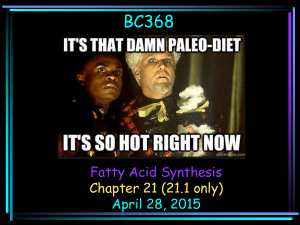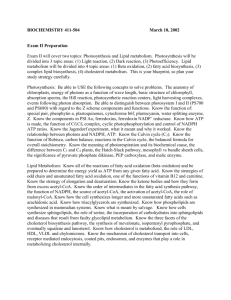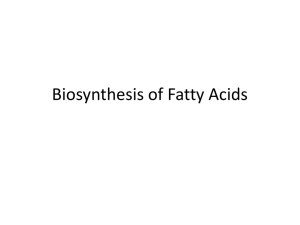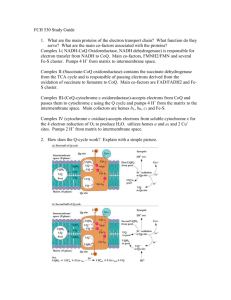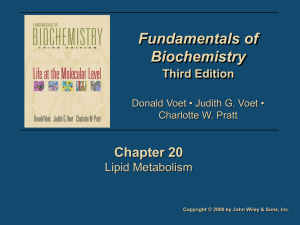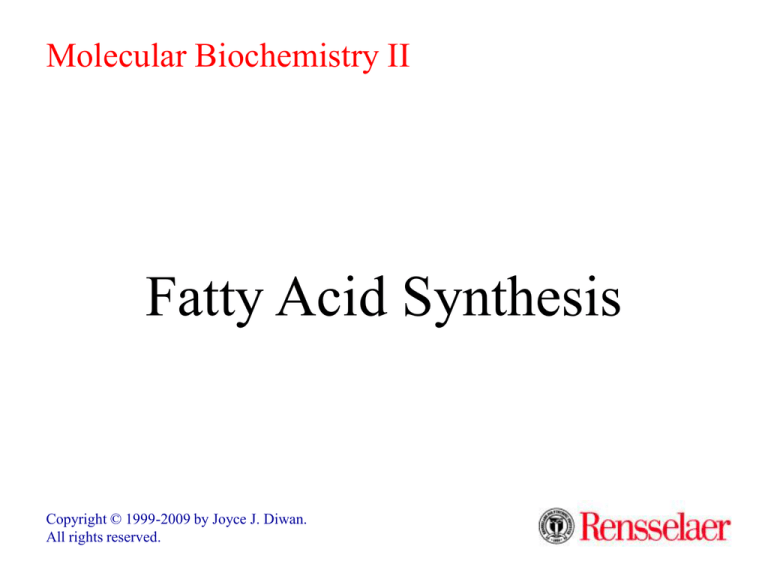
Molecular Biochemistry II
Fatty Acid Synthesis
Copyright © 1999-2009 by Joyce J. Diwan.
All rights reserved.
O
H3C
C
SCoA
acetyl-CoA
The input to fatty acid
synthesis is acetyl-CoA,
which is carboxylated to
malonyl-CoA.
O
OOC
CH2
C
SCoA
malonyl-CoA
ATP-dependent carboxylation provides energy input.
The CO2 is lost later during condensation with the
growing fatty acid.
The spontaneous decarboxylation drives the
condensation reaction.
Acetyl-CoA
Carboxylase
catalyzes the
2-step reaction
by which
acetyl-CoA is
carboxylated
to form
malonyl-CoA.
Enzyme-biotin
HCO3 + ATP
1
ADP + Pi
Enzyme-biotin-CO2
O
ll
CH3-C-SCoA
acetyl-CoA
2
Enzyme-biotin
O
-
ll
O2C-CH2-C-SCoA
malonyl-CoA
As with other carboxylation reactions, the enzyme
prosthetic group is biotin.
ATP-dependent carboxylation of the biotin, carried out at
one active site 1 , is followed by transfer of the carboxyl
group to acetyl-CoA at a second active site 2 .
Enzyme-biotin
HCO3 + ATP
1
ADP + Pi
Enzyme-biotin-CO2
O
ll
CH3-C-SCoA
acetyl-CoA
2
Enzyme-biotin
O
-
ll
O2C-CH2-C-SCoA
malonyl-CoA
The overall reaction, which is spontaneous, may be
summarized as:
HCO3 + ATP + acetyl-CoA ADP + Pi + malonyl-CoA
O
O
C
C
O
N
NH
CH CH
CH
H2C
S
Carboxybiotin
O
O
(CH2)4 C
NH
C
(CH2)4 CH
lysine NH
residue
Biotin is linked to the enzyme by an amide bond between
the terminal carboxyl of the biotin side chain and the
e-amino group of a lysine residue.
The combined biotin and lysine side chains act as a long
flexible arm that allows the biotin ring to translocate
between the 2 active sites.
Acetyl-CoA Carboxylase, which converts acetyl-CoA
to malonyl-CoA, is the committed step of the fatty acid
synthesis pathway.
The mammalian enzyme is regulated, by
phosphorylation
allosteric control by local metabolites.
Conformational changes associated with regulation:
In the active conformation, Acetyl-CoA
Carboxylase associates to form multimeric
filamentous complexes.
Transition to the inactive conformation is
associated with dissociation to yield the
monomeric form of the enzyme (protomer).
AMP functions as an energy sensor and regulator of
metabolism.
When ATP production does not keep up with needs, a
higher portion of a cell's adenine nucleotide pool is in
the form of AMP.
AMP promotes catabolic pathways that lead to
synthesis of ATP.
AMP inhibits energy-utilizing synthetic pathways.
E.g., AMP regulates fatty acid synthesis and catabolism
by controlling availability of malonyl-CoA.
O
H3C
AMP-Activated Kinase
catalyzes phosphorylation
of Acetyl-CoA
Carboxylase.
This causes inhibition of
ATP-utilizing of malonylCoA production.
C
SCoA
acetyl-CoA
ATP + HCO3
ADP + Pi
Acetyl-CoA
Carboxylase
(inhibited by
AMP-Activated
Kinase)
O
OOC
CH2
C
SCoA
malonyl-CoA
Fatty acid synthesis is diminished by lack of the
substrate malonyl-CoA.
As discussed earlier, fatty acid oxidation is stimulated
due to decreased inhibition by malonyl-CoA of transfer
of fatty acids into mitochondria.
O
H3C
C
SCoA
acetyl-CoA
ATP + HCO3
ADP + Pi
Acetyl-CoA
Carboxylase
(inhibited by
AMP-Activated
Kinase)
A cAMP cascade,
O
activated by glucagon &
OOC CH2 C SCoA
epinephrine when blood
malonyl-CoA
glucose is low, may also
result in phosphorylation of Acetyl-CoA Carboxylase
via cAMP-Dependent Protein Kinase.
With Acetyl-CoA Carboxylase inhibited, acetyl-CoA
remains available for synthesis of ketone bodies, the
alternative metabolic fuel used when blood glucose is low.
Phosphorylated protomer of
Acetyl-CoA Carboxylase (inactive)
Citrate
Dephosphorylated,
e.g., by insulinactivated Protein
Phosphatase
Palmitoyl-CoA
Phosphorylated, e.g., via
AMP-activated Kinase
when cellular stress or
exercise depletes ATP.
Dephosphorylated Polymer of
Acetyl-CoA Carboxylase (active)
Regulation of Acetyl-CoA Carboxylase
The antagonistic effect of insulin, produced when
blood glucose is high, is attributed to activation of
Protein Phosphatase.
Phosphorylated protomer of
Acetyl-CoA Carboxylase (inactive)
Citrate
Regulation of
Acetyl-CoA
Carboxylase by
local metabolites:
Dephosphorylated,
e.g., by insulinactivated Protein
Phosphatase
Palmitoyl-CoA
Phosphorylated, e.g., via
AMP-activated Kinase
when cellular stress or
exercise depletes ATP.
Dephosphorylated Polymer of
Acetyl-CoA Carboxylase (active)
Regulation of Acetyl-CoA Carboxylase
Palmitoyl-CoA (product of Fatty Acid Synthase) promotes
the inactive conformation, diminishing production of
malonyl-CoA, the precursor of fatty acid synthesis.
This is an example of feedback inhibition.
Glucose-6-phosphatase
glucose-6-P
glucose
Gluconeogenesis
Glycolysis
pyruvate
fatty acids
acetyl CoA
Citrate
allosterically
activates AcetylCoA Carboxylase.
ketone bodies
cholesterol
citrate
oxaloacetate
Krebs Cycle
[Citrate] is high when there is adequate acetyl-CoA
entering Krebs Cycle.
Excess acetyl-CoA is then converted via malonyl-CoA to
fatty acids for storage.
Fatty acid synthesis from acetyl-CoA & malonyl-CoA
occurs by a series of reactions that are:
in bacteria catalyzed by 6 different enzymes plus a
separate acyl carrier protein (ACP)
in mammals catalyzed by individual domains of a very
large polypeptide that includes an ACP domain.
Evolution of the mammalian Fatty Acid Synthase
apparently has involved gene fusion.
NADPH serves as electron donor in the two reactions
involving substrate reduction.
The NADPH is produced mainly by the Pentose Phosphate
Pathway.
H
H3N+
C
SH
COO
CH2
CH2
CH2
SH
NH
Fatty Acid
cysteine
Synthase
prosthetic groups:
the thiol of the sidechain of a cysteine
residue of Condensing
Enzyme domain.
the thiol of
phosphopantetheine,
equivalent in structure
to part of coenzyme A.
Coenzyme A
C
-mercaptoethylamine
O
CH2
CH2
pantothenate
NH
C
NH2
O
ADP-3'phosphate
HO
C
H
H3C
C
CH3 O
H2C
O
P
N
N
O
O
O
P
N
N
O
CH2
O
O
H
H
O
H
OH
H
phosphopantetheine
O
P
O
O
SH
phosphopantetheine
of acyl carrier protein
CH2
Phosphopantetheine
(Pant) is covalently
linked via a phosphate
ester to a serine OH of
the acyl carrier protein
domain of Fatty Acid
Synthase.
CH2
-mercaptoethylamine
NH
C
O
CH2
CH2
pantothenate
NH
The long flexible arm
of phosphopantetheine
helps its thiol to move
from one active site to
another within the
complex.
C
O
HO
C
H
H3 C
C
CH3 O
H2C
O
P
NH
O
O
phosphate
CH2
CH
C
serine
residue
O
Malonyl/acetyl-CoA Dehydratase Enoyl
-Ketoacyl ACP Thioesterase
N- Condensing
-C
Enzyme (Cys) Transacylase (Ser)
Reductase Reductase (Pant)
Order of domains in primary structure of mammalian Fatty Acid Synthase
As each of the substrates acetyl-CoA & malonyl-CoA
bind to the complex, the initial attacking group is the
oxygen of a serine hydroxyl group of the
Malonyl/acetyl-CoA Transacylase enzyme domain.
Each acetyl or malonyl moiety is transiently in ester
linkage to this serine hydroxyl, before being transferred
into thioester linkage with the phosphopantetheine
thiol of the acyl carrier protein (ACP) domain.
Acetate is subsequently transferred to a cysteine thiol of
the Condensing Enzyme domain.
acetyl-S-CoA HS-CoA
Pant
SH
Cys
SH
Pant
1
SH
CO2
malonyl-S-CoA HS-CoA
Cys
Pant
2
S
C
CH3
O
Cys
S
S
C
O C
CH2
1 Malonyl/acetyl-CoA-ACP Transacylase COO
2 Malonyl/acetyl-CoA-ACP Transacylase
3 Condensing Enzyme (-Ketoacyl Synthase)
CH3
3
O
Pant
Cys
S
SH
C
O
CH2
C
CH3
The condensation reaction (step 3) involves
decarboxylation of the malonyl moiety, followed by
attack of the resultant carbanion on the carbonyl
carbon of the acetyl (or acyl) moiety.
O
NADPH NADP+
Pant
Cys
S
SH
C
O
O
CH3
Pant
Cys
S
SH
C
O
HC
5
Pant
Cys
S
SH
C
CH
CH2
CH2
C
4
NADPH NADP+
H2O
OH
CH3
HC
CH3
O
6
Pant
Cys
S
SH
C
O
CH2
CH2
CH3
4 -Ketoacyl-ACP Reductase
5 -Hydroxyacyl-ACP Dehydratase
6 Enoyl-ACP Reductase
4. The -ketone is reduced to an alcohol by e transfer
from NADPH.
5. Dehydration yields a trans double bond.
6. Reduction by NADPH yields a saturated chain.
Malonyl-S-CoA HS-CoA
Pant
Cys
S
SH
C
O
7
Pant
Cys
SH
S
C
2
O
Pant
Cys
S
S
C
O
C
CH2
CH2
CH2
CH2
CH2
CH2
COO
CH2
CH3
CH3
O
CH3
7 Condensing Enzyme
2 Malonyl/acetyl-CoA-ACP Transacylase (repeat).
Following transfer of the growing fatty acid from
phosphopantetheine to the Condensing Enzyme's
cysteine sulfhydryl, the cycle begins again, with
another malonyl-CoA.
Product release:
When the fatty acid is 16 carbon atoms long, a
Thioesterase domain catalyzes hydrolysis of the
thioester linking the fatty acid to phosphopantetheine.
The 16-C saturated fatty acid palmitate is the final
product of the Fatty Acid Synthase complex.
Malonyl/acetyl-CoA Dehydratase Enoyl
-Ketoacyl ACP Thioesterase
N- Condensing
-C
Enzyme (Cys) Transacylase (Ser)
Reductase Reductase (Pant)
Order of domains in primary structure of mammalian Fatty Acid Synthase
The primary structure of the mammalian Fatty Acid
Synthase protein is summarized above.
Fatty Acid Synthase in mammals is a homo-dimer.
X-Ray crystallographic
analysis at 3.2 Å resolution
shows the dimeric Fatty Acid
Synthase to have an X-shape.
The 2 copies of the protein are
displayed at right in different
colors.
Fatty Acid Synthase PDB 2VZ8
Malonyl/acetyl-CoA Dehydratase Enoyl
-Ketoacyl ACP Thioesterase
N- Condensing
-C
Enzyme (Cys) Transacylase (Ser)
Reductase Reductase (Pant)
Order of domains in primary structure of mammalian Fatty Acid Synthase
The domain arrangement is shown below.
Each copy of the dimeric protein has an S shape, with the
N-terminal KS (Condensing Enzyme / -Ketoacyl
Synthase) domain folded back to form part of the central
interaction domain.
KR = -Ketoacyl Reductase;
ER = Enoyl Reductase;
DH = Dehydratase;
KS = -Ketoacyl Synthase
(Condensing Enzyme);
MAT = Malonyl/Acetyl-CoA
Transacylase.
KR
MAT
ER
ER
DH
DH
KS
KS
KR
MAT
Arrangement of domains
in Fatty Acid Synthase
“arm”
“leg”
Malonyl/acetyl-CoA Dehydratase Enoyl
-Ketoacyl ACP Thioesterase
N- Condensing
-C
Enzyme (Cys) Transacylase (Ser)
Reductase Reductase (Pant)
Order of domains in primary structure of mammalian Fatty Acid Synthase
The X-ray analysis does not resolve the C-terminal ACP
(acyl carrier protein) & Thioesterase domains, predicted
from the primary structure to be near the KR domains.
These domains may be too flexible to be resolved by
crystallography.
KR = -Ketoacyl Reductase;
ER = Enoyl Reductase;
DH = Dehydratase;
KS = -Ketoacyl Synthase
(Condensing Enzyme);
MAT = Malonyl/Acetyl-CoA
Transacylase.
KR
MAT
ER
ER
DH
DH
KS
KS
KR
MAT
Arrangement of domains
in Fatty Acid Synthase
“arm”
“leg”
Fatty Acid Synthase complex is somewhat asymmetric.
There is evidence for conformational changes relating to
catalysis.
Protein flexibility may facilitate transfer of ACP-attached
reaction intermediates among the several active sites in
each half of the complex.
For images see:
website (ETH Zurich)
website (Asturias lab,
Scripps)
article (Maier, Leibundgut
& Ban; requires subscription
to Science).
Fatty Acid Synthase PDB 2VZ8
Explore with Chime the structure of the
Mammalian Fatty Acid Synthase III.
Palmitate, a 16-C saturated fatty acid, is the final product of the Fatty
Acid Synthase reactions.
1
1. a. How many acetyl-CoA used for initial priming of enzyme? _____
b. How many acetyl-CoA used for synthesis of each malonate? ____
1
c. How many malonate used (how many reaction cycles) per
7
synthesis of one 16-C palminate? ________
d. Total acetyl-CoA used for priming & for syntheisis of malonate,
a + b(c): ________
8
2. a. How many ~P bonds of ATP used for synthesis of each
1
malonate? ________
b. Total ~P bonds of ATP used for synthesis of one 16-C palmitate,
7
2a(1c): ________
3. a. How many NADPH used per reaction cycle? __________
2
b. Total NADPH used per synthesis of one 16-C palmitate, 3a(1c):
14
_________
Summary (ignoring H+ & water):
Write a balanced equation for synthesis of palmitate from
acetyl-CoA, listing net inputs and outputs:
8 acetyl-CoA + 14 NADPH + 7 ATP
palmitate + 14 NADP+ + 8 CoA + 7 ADP + 7 Pi
Summary based on malonate as an input:
acetyl-CoA + 7 malonyl-CoA + 14 NADPH
palmitate + 7 CO2 + 14 NADP+ + 8 CoA
Fatty acid synthesis occurs in the cytosol. Acetyl-CoA
generated in mitochondria is transported to the cytosol
via a shuttle mechanism involving citrate.
-Oxidation & Fatty Acid Synthesis
Compared
Oxidation Pathway Fatty Acid Synthesis
mitochondrial matrix
cytosol
acyl carriers
(thiols)
Coenzyme-A
phosphopantetheine
(ACP) & cysteine
e acceptors/donor
FAD & NAD+
NADPH
-OH intermediate
L
D
2-C product/donor
acetyl-CoA
malonyl-CoA
(& acetyl-CoA)
pathway location
Fatty Acid Synthase is transcriptionally regulated.
In liver:
Insulin, a hormone produced when blood glucose is
high, stimulates Fatty Acid Synthase expression.
Thus excess glucose is stored as fat.
Transcription factors that that mediate the stimulatory
effect of insulin include USFs (upstream stimulatory
factors) and SREBP-1.
SREBPs (sterol response element binding proteins)
were first identified for their regulation of cholesterol
synthesis.
Polyunsaturated fatty acids diminish transcription of
the Fatty Acid Synthase gene in liver cells, by
suppressing production of SREBPs.
In fat cells:
Expression of SREBP-1 and of Fatty Acid Synthase is
inhibited by leptin, a hormone that has a role in
regulating food intake and fat metabolism.
Leptin is produced by fat cells in response to excess fat
storage.
Leptin regulates body weight by decreasing food intake,
increasing energy expenditure, and inhibiting fatty acid
synthesis.
Elongation beyond the 16-C length of the palmitate
product of Fatty Acid Synthase is mainly catalyzed by
enzymes associated with the endoplasmic reticulum (ER).
ER enzymes lengthen fatty acids produced by Fatty Acyl
Synthase as well as dietary polyunsaturated fatty acids.
Fatty acids esterified to coenzyme A serve as substrates.
Malonyl-CoA is the donor of 2-carbon units in a reaction
sequence similar to that of Fatty Acid Synthase except that
individual steps are catalyzed by separate proteins.
A family of enzymes designated Fatty Acid Elongases or
ELOVL (elongation of very long chain fatty acid) catalyze
the initial condensation step.
10 9
O
C
OH
oleate 18:1 cis D9
Desaturases introduce double bonds at specific
positions in a fatty acid chain.
Mammalian cells are unable to produce double bonds
at certain locations, e.g., D12.
Thus some polyunsaturated fatty acids are dietary
essentials, e.g., linoleic acid, 18:2 cis D9,12 (18 C atoms
long, with cis double bonds at carbons 9-10 & 12-13).
10 9
O
C
OH
oleate 18:1 cis D9
Formation of a double bond in a fatty acid involves the
following endoplasmic reticulum membrane proteins in
mammalian cells:
NADH-cyt b5 Reductase, a flavoprotein with FAD
as prosthetic group.
Cytochrome b5, which may be a separate protein or
a domain at one end of the desaturase.
Desaturase, with an active site that contains two
iron atoms complexed by histidine residues.
The desaturase catalyzes a mixed function oxidation
reaction.
There is a 4-electron reduction of O2 2 H2O as a fatty
acid is oxidized to form a double bond.
2e pass from NADH to the desaturase via the
FAD-containing reductase & cytochrome b5, the
order of electron transfer being:
NADH FAD cyt b5 desaturase
2e are extracted from the fatty acid as the double
bond is formed.
E.g., the overall reaction for desaturation of stearate
(18:0) to form oleate (18:1 cis D9) is:
stearate + NADH + H+ + O2 oleate + NAD+ + 2H2O

